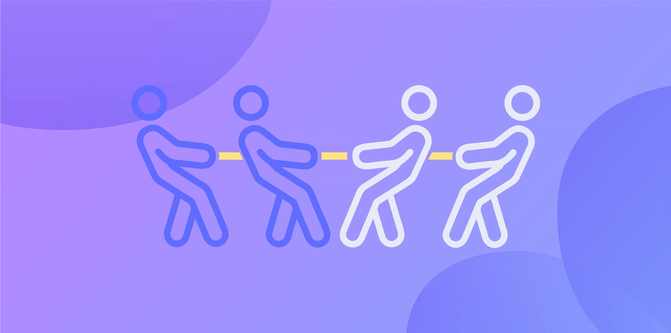Top-Down vs. Bottom-Up Approach to Management

Which management approach is best?
Being a great leader is more than simply managing. It requires a combination of alignment, organization, communication, and empathy to support your team in driving results. When it comes to managerial approaches within a company, there are two commonly practiced methods; top-down and bottom-up.
A top-down approach
When leadership determines an organization’s direction and the team executes that plan, it signifies top-down management. A top-down approach means that decisions are made at the highest level and communicated to the rest of the company.
How does the top-down approach work?
Usually, high-level leaders start with the bigger picture - establishing goals based on the company mission and vision - and then allocate responsibilities to individuals and teams that’ll achieve those goals. The planning process is solely established by management, with little room for employee input and feedback. It’s often referred to as a command-and-control system.
When would you use a top-down approach?
Due to its straightforward structure, organizations with multiple levels of management, various teams and departments, and complex processes benefit from using a top-down strategy. These organizations are usually heavily regulated industries and institutions, including:
- The military
- Healthcare
- The financial sector
- Manufacturing
In these cases, top-down management is the best approach because clear lines of authority, standardized processes, and quality control are essential to the organization's success.
What are the benefits of a top-down approach?
There are many advantages to a top-down approach to management. Since the decision-making processes are centralized at the leadership level, it reduces ambiguity surrounding goals. It is easy to provide clarity, and expectations are based on one higher input.
Tasks also tend to be implemented faster using a top-down approach. There’s little opportunity to get multiple perspectives and revisions on work, meaning that ideas are pushed directly to the execution phase.
What are the risks of a top-down approach?
The tradeoff of limited feedback for faster execution increases the risk that leaders make the wrong decision for the company and employees. Especially in larger organizations, high-level managers are often disconnected from changing customer needs and pain points. Without employee input, leadership may not have the most relevant information.
Another disadvantage of limited feedback is that employees may lose respect for management because their ideas and opinions feel undervalued. The divide between high-level leaders and employees creates lower engagement and decreased job satisfaction.
What are the pros and cons of a top-down approach?
- Widespread familiarity with the system. Employees know what to expect from the management style because it's the traditional work structure.
- Clear communication of goals and projects because decisions are made by the top few leaders.
- Faster implementation of tasks and projects because expectations are clearly distributed to each individual.
- The company mission, values, and goals are explicitly expressed.
- Employees may have no attachment to the company goals, leading to low engagement.
- Limited space for creativity and innovation, leading to static processes and development.
- Poor leadership could lead to poor decision-making and unhappy employees.
- Less job satisfaction for lower-level employees.
A bottom-up approach
How does a bottom-up approach work?
A bottom-up approach values collaboration across the organization to determine the steps needed to achieve the company goals. In other words, the leaders still set the goal, but the steps to get there are devised by the individuals and teams. This method gives teams greater autonomy in how they approach the work, leading to more trust, engagement, and creativity.
When would you use a bottom-up approach?
As a more flexible management method, a bottom-up approach is found in industries where optimization is a top priority. It uses employee skills to experiment and find innovative solutions in a given industry. Some examples include:
- Software development
- Grassroot efforts
- Journalism
What are the benefits of a bottom-up approach?
A bottom-up approach typically comes with greater employee satisfaction. Since the team and individuals create projects and tasks to complete the company goal, employees know that their voices are heard and contribute to the overall vision. This leads to increased motivation, better employee engagement, and more productivity.
This approach also allows employees to provide feedback, which adds value to their daily work. When leaders ask for feedback, employees know their voices have an impact, and their work holds value. Feedback also benefits the company because it brings more perspectives and ideas to the table since it comes from diverse people and different departments.
What are the risks of a bottom-up approach?
Leaders can find difficulties executing the right amount of structure and guidance in a bottom-up approach. Some employees may need more direction and supported development to overcome work-related challenges effectively.
Another possible limitation is if the company goals are not visual to the team, making informed decisions about where they should place their efforts difficult. That’s why communicating goals is critical to a productive bottom-up management approach.
What are the pros and cons of bottom-up management?
- More informed decisions by leadership.
- Increased engagement and productivity because employees feel their input and contributions are valued.
- Better team morale because everyone has equal insights into the day-to-day processes.
- More room for creativity and innovation because employees are encouraged to find solutions and hit targets in their own ways.
- Teams are more aligned to the big picture and company values. They feel a part of the mission to get there.
- There may be a shift in leadership dynamics if your organization formerly implemented a top-down approach.
- Lack of high-level insight without a reporting system.
- Some employees may feel frustrated with less guidance.

What management style is best for you?
If you want to choose a particular style of management, here are some factors to consider:
1. Do you want one style or a hybrid?
Every company is different, with varying levels of flexibility. You may want to see what elements from each approach best suit your organization. For example, there might be financial decisions best made by leadership and then filtered down to employees. In another case, leaders may rely heavily on employee feedback and input to make decisions on a higher level. Evaluate what your company needs and create a distinct approach tailored to you.
2. Understand your company culture
Think about how your culture will respond to both approaches. Are your employees connected to the company mission and values? Do you foster an environment that supports feedback? Management and culture go hand-in-hand, so it’s vital to understand the attitudes and behaviors of your organization so you can implement the best approach for you.
3. Consider your organization's size
Typically, smaller organizations benefit from a bottom-up approach because everyone has a voice and contributes to their initial growth. Larger companies usually function well with a top-down approach. Take into account the size of your team and where it’s headed for the best managerial style.
Both management styles, or a combination of the two, bring value to an organization. What’s more important is ensuring managers are trained and aligned to implement these approaches in the most effective way possible. One way to do this is through OKRs.
What is the best way to manage a top-down or bottom-up approach?
OKRs can be a great strategy to bring everyone together around company goals. An acronym for “objectives and key results,” OKRs help align strategies to put everyone’s focus on a shared outcome. Employing OKRs aids management in a few significant ways:
- They increase productivity by clarifying goals and expectations, aligning the entire company with a joint mission.
- They give employees a better understanding of how objectives affect strategies and the company vision, driving engagement and increasing job satisfaction.
- They help the company understand which goals are practical and why, allowing management to make more informed decisions.
- They end micromanagement tendencies by providing the necessary tools needed to complete projects and tasks, encouraging your team to do their best work.
The Future of Management
Management style is a vital part of an organization's culture. Whether you opt for a top-down, bottom-up, or hybrid approach, you're sure to find a method that positively supports your team and employees.




